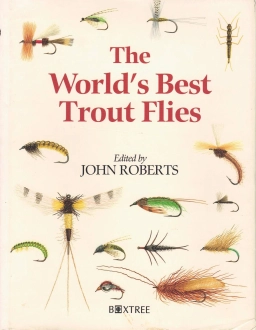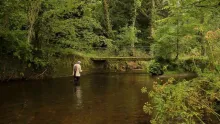This is a book that I bought when attending a very well set up fly tying arrangement here in Denmark just after new year, and already at the arrangement I met two of the tyers featured in the book: Oliver Edwards (UK) and Mogens Espersen (Denmark).
This review was originally shared on the mailing list flyfish@, which was a virtual meeting place for a lot of international fly anglers and tyers in the early dawn of online fly fishing and tying communities in the 90's.
Date: Tue, 23 May 1995 23:12:23 +0100 (MET)
Hi fellow Book page browsers,
Time for another book review to fight Haikus, BS and semi-to-full-blown flame threads. I love the list, but there sure is a lot of unuseful garbage in my digests sometimes. I don't mind the garbage, but I mind when it's more than half the volume. Stop within reason, please...
No one has yet asked me to stop my reviews, so I'll keep on until such protests occur.
This time it's another fly tying book. It should be noted when mentioning this fact, that it's purely by coincidence that the list of books reviewed until now only consists of tying books. As mentioned before I only review what I buy, and as most of my books on fishing are in Danish they are of limited interest to the list. This might change in the future.
Free review copies haven't found their way to Denmark yet, so the frequency of reviews will still be depending on my book budget ;-).
- John Roberts (ed.): The World's Best Trout Flies
- Published by Boxtree Limited, London, 1994
- Price: DKK 375.- (Bought in Denmark, where prices are high).
- Seen at UK£ 19.99 in an English magazine.
This is a book that I bought when attending a very well set up fly tying arrangement here in Denmark just after New Year. Already at the arrangement I met two of the tyers featured in the book: Oliver Edwards (UK) and Mogens Espersen (Denmark). Before buying I had met Hans Weilenmann (of list fame) and since I've had the chance to meet several more of the tyers: Al Beatty, Wayne Luallen, Theo Bakelaar and others. Many of the rest mentioned in this book were already known to me from other books, magazines etc. like Rene Harrop, Darrel Martin, Roman Moser, Torril Kolbu and many more.
As it might be understood from this lineup, the book features an impressive range of skilled fly tyers. And that is exactly the aim of this book: to present a series of tyers and their trout flies in order to fulfill what its title promises: a presentation of the world's best trout flies.
Of course it doesn't keep this promise. No one in their best mind will seriously say that they have the list of _the_ best trout flies in the world. But the book does do a good job of trying to get there, and looking at the names can assure anybody, that the flies at least can't be the worst.
Each tyer is treated in a separate chapter, which consists of a small presentation written by the editor, a text written by the tyer and the patterns selected by him or her.
The introduction is mostly funny, slightly ironic but still respectful, and emphasizes the special personality of each tyer. Judging from the ones that I have met, John Roberts either knows each tyer well or has done his homework. The text written by each tyer is a bit more varying. Some are serious, some entertaining. Some are in depth on a specific subject while others are more superficial. Some deal with the flies, some with the locations or countries they are fished in and some again with anecdotes and history. Unfortunately all but a few leave the impression of too much information in too little space. I felt that a lot of these tyers had more on their heart than was put on paper. Each tyer has approximately two pages of text plus one for the patterns and one for a painting of the flies.
The paintings are done by Aideen Canning, and seem to be watercolors of some kind. They are beautiful, but in my opinion still one of the weak parts of the book. It is often said that paintings or drawings will show a fly with more clarity than a photo, but in this case it's not true. I think I would have preferred photos in a good quality. Even though a lot of the flies have been painted from two or more sides in order to show the proportions and three dimensional shape, I find the paintings very two dimensional and flat'. All the flies are shown in a clear sideview, which resembles a construction drawing more than a artistic painting, and even though it shows pretty clearly the way the fly looks and can be tied, I find it quite uninspiring. One thing is that it's difficult to get an idea of each tyers specific style. The flies all seem too symmetrical and regular in their style, and I can't really believe that the tyers are that uniform in their way of tying flies. And even though I do not doubt that the painter has done her best to render the colors correctly, I fear that the colors have come out a bit on the clear side.
The paintings leave me with the impression that many of the flies were painted as the painter thought they should look more than how they actually looked.
Each patterns is followed by a fairly short list of materials. Together with the painting it is enough to tie the fly correctly though. In some cases the tyer mentions one or more specific patterns in the text and some details of how to tie it, and in a few cases there are supplementary drawings of the process, like Torril Kolbu's crocheted bodies, van Klinken's Klinkenhamer and Mogens Espersen's drawings of different wet fly hackles. These drawings work well, and do in many ways tell a lot more about the flies and the tyer than the text and the painting. There should have been more of these small personal supplements.
The last extra chapter on hair by Al Beatty is much in the direction of what I mean. It's a fairly short, but still in depth lesson on hair for tails and wings. It's no more than two and a half pages, but Al still manages to get a lot of practical information passed over to the reader. I know this book is not meant as a course in fly tying, but I still miss chapters like this. A few other tyers cover specific techniques, but I'd like to see more.
The book also shows some nice color photos of fish and fishing action. Most of them show beautiful places, but are not exceptional in any way. They add little to the book except leaf-through-value'. A proper photographic portrait of each tyer would have added much more.
The book is offers good reading, but where the new reader is likely to browse the photos, drawings and paintings at first, then read the introduction of each tyer and skip the longer' texts, the real value of the book shows in the individual texts.
And the value of the book is not in the patterns -- even though it's interesting to see what kind of flies these people tie and use -- but in the impression that the book leaves of each tyer. When you meet them, you feel like you know them a bit already.
Pleasant reading
Hand picked for this article
- Log in to post comments










